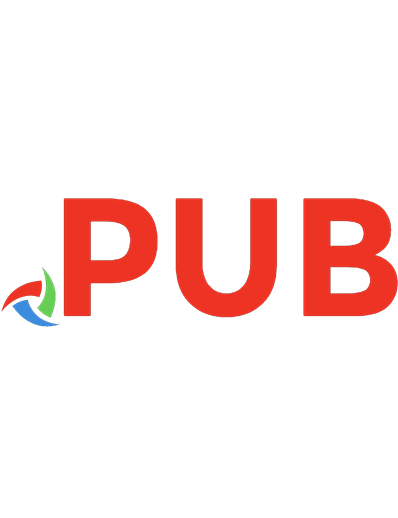Effective Crisis Management: A Robust A-Z Guide for Demonstrating Resilience by Utilizing Best Practices, Case Studies, and Experiences
Develop crisis plans, practise them, and minimise threats Key Features ● Understand the reasons why you should expect
167 54
English Pages 230 Year 2023
Table of contents :
Cover Page
Title Page
Copyright Page
Dedication Page
About the Author
About the Reviewer
Acknowledgement
Preface
Errata
Table of Contents
1. Introduction
Structure
Objectives
Expect the unexpected
Digital disruption
Societal disruption
Breaking down the norms
The difference between an incident and a crisis
Conclusion
2. Action
Structure
Objectives
Establishing accountability for actions
Assigning decision makers to actions
Bringing actions to life
Building the action plan
The danger of making assumptions
Conclusion
Reflection
Suggested actions
3. Believable
Structure
Objectives
Establishing believability
Why?
Avoid being in denial
Building trust
Conclusion
Reflection
Suggested actions
4. Communication
Structure
Objectives
Case study 1
Tailoring stakeholder communications
When to communicate?
Method of communication
Who will communicate?
Verifying communications
Conclusion
Reflection
Suggested actions
5. Diligence
Structure
Objectives
Oversight of risks
Establishing a duty of care
Diligence in a crisis
Tick-boxing for compliance
Conclusion
Reflection
Suggested actions
6. Empathy
Structure
Objectives
Perils of victim blaming
Demonstrating empathy for people
Demonstrating empathy for organizations
Conclusion
Reflection
Suggested actions
7. Facts
Structure
Objectives
The pursuit of truth
Misinformation versus disinformation
Emerging impact of disinformation campaigns
Fact checking
Digital forensics
Conclusion
Reflection
Suggested actions
8. Gravitas
Structure
Objectives
Leadership and gravitas
Demonstrating gravitas
Conclusion
Reflection
Suggested actions
9. Honesty
Structure
Objectives
Demonstrating integrity
Believability versus honesty
Dealing with whistleblowing
Dealing with grievances
Conclusion
Reflection
Suggested actions
10. Investigation
Structure
Objectives
Co-ordinating the investigation
Learning from public inquiries
Case study 2
Results of investigations
Conclusion
Reflection
Suggested actions
11. Justice
Structure
Objectives
Apportioning blame
Dealing with negligence
Case study 3
Miscarriages of justice
Conclusion
Reflection
Suggested actions
12. Knowledge
Structure
Objectives
Turning knowledge into intelligence
Case study 4
Education and awareness
Sharing and collaboration
Conclusion
Reflection
Suggested actions
13. Lessons
Structure
Objectives
Utilizing the power of hindsight and foresight
The fallacy of black swan events
Case study 5
Importance of isomorphic learning
Applying lessons
Conclusion
Reflection
Suggested actions
14. Media
Structure
Objectives
Reliance on the media in a crisis
Communicating with the media
Dealing with censorship
Conclusion
Reflection
Suggested actions
15. Near Miss
Structure
Objectives
A game of chance
Incident containment
What would happen next?
Conclusion
Reflection
Suggested actions
16. Opportunity
Structure
Objectives
Beyond the comfort zone
A leap of faith
Encountering seismic change
Pivoting into crisis management
Dare to be bold
Turning negatives into positives
Conclusion
Reflections
Suggested actions
17. People
Structure
Objectives
Nothing is more important than people.
People over profit
The unpredictability of people
Conclusion
Reflection
Suggested actions
18. Questions
Structure
Objectives
Questions to ask pre-incident
Questions to ask during an incident
Questions to ask post incident
Conclusion
Reflection
Suggested actions
19. Resilience
Structure
Objectives
Future-proofing resilience
Embracing a culture of resilience and security
Demonstrating organizational resilience
Strengthening the resilience of others
Conclusion
Reflection
Suggested actions
20. Strategy
Structure
Objectives
Strategy and culture
Developing scenarios
Exercising the crisis response
Conclusion
Reflection
Suggested actions
21. Time
Structure
Objectives
Time is of the essence
The past
The present
The future
Conclusion
Reflection
Actions
22. Underdog
Structure
Objectives
A tale of two companies
Survival of the fittest
Disrupted or disrupter?
Conclusion
Reflection
Suggested actions
23. Victory
Structure
Objectives
Protecting the castle
Understanding human needs
Positive reinforcement
Conclusion
Reflection
Suggested actions
24. Wellbeing
Structure
Objectives
Maintaining wellbeing in a crisis
Managing the stressors
Establishing emotional resilience
Case study 6
Case study 7
Finding your path
Dealing with trauma
Recognizing trauma in others
Conclusion
Reflection
Suggested actions
25. X - Marks the Spot
Structure
Objectives
Retracing steps to establish a timeline
Conclusion
Reflection
Suggested actions
26. Y-Why
Structure
Objectives
Performing deep analysis
Establishing multiple lines of inquiry
Correlating cause and effect
Conclusion
Reflection
Suggested actions
27. Zero Trust
Structure
Objectives
The principles of zero trust
A business perspective on zero trust
Crossing the boundary of technology and cybersecurity
Conclusion
Reflection
Suggested actions
28. Final Thoughts
Index


![Total Revenue Management (TRM): Case Studies, Best Practices and Industry Insights [1st ed.]
9783030469849, 9783030469856](https://dokumen.pub/img/200x200/total-revenue-management-trm-case-studies-best-practices-and-industry-insights-1st-ed-9783030469849-9783030469856.jpg)

![Best Practices for Effective Boards [1 ed.]
9780834129535, 9780834128347](https://dokumen.pub/img/200x200/best-practices-for-effective-boards-1nbsped-9780834129535-9780834128347.jpg)


![Virtual and Innovative Quality Management Across the Value Chain: Industry Insights, Case Studies and Best Practices (Management for Professionals) [1st ed. 2023]
9783031300899, 9783031300882, 3031300882](https://dokumen.pub/img/200x200/virtual-and-innovative-quality-management-across-the-value-chain-industry-insights-case-studies-and-best-practices-management-for-professionals-1st-ed-2023-9783031300899-9783031300882-3031300882.jpg)


